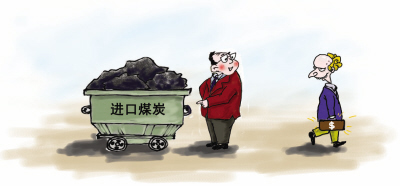 According to the latest data provided by China’s customs department recently, in 2012, China’s cumulative imports increased by 107.6 million tons compared to 2011, a year-on-year increase of 59%.
According to the latest data provided by China’s customs department recently, in 2012, China’s cumulative imports increased by 107.6 million tons compared to 2011, a year-on-year increase of 59%. Also after May of this year, coal prices fell rapidly and coal inventories increased, making it difficult for coal companies to operate. In addition to the slowdown in demand and release of production capacity, the impact of increased imports of coal is an important reason. How should we view the surge in importation in the coal market? To what extent will imported coal change China's coal market and energy supply?
Imported coal influxed into the Chinese market. "The goods on the dumps on both sides of the road are piled up on a hill, and most of the goods are covered with rain-proof cloth. From the standing signs, it can be seen that these are imported from Australia and Vietnam. There are at least six or seven hundred tons of raw coal,†Wang Lijie, director of the Institute of Energy Economics at China University of Mining and Technology, told reporters about the sight he had seen in Fangchenggang, Guangxi. It is understood that not only has a large amount of imported coal from Southeast Asia and Australia been stockpiled, but some even come from the United States across the ocean.
Since 2009, China has become a net importer of coal from a net coal exporter, and the net coal imports have increased year by year from 109 million tons in 2009 and reached a new peak in 2012. According to Wang Lijie, in the first half of 2012, the CIF of imported coal was around US$90/ton, domestic coal prices were around seven or eight hundred yuan per ton, prices were upside down, and domestic coal imports reached 160 million tons; Coal prices fell gradually and imports decreased to 130 million tons.
The data shows that since 2012, the price of the Baroam's Index, which reflects international coal prices, fell from US$117.55/tonne at the beginning of 2012 to a low of US$80.35/ton, a decrease of 31.6%.
According to coal marketing expert Li Chaolin, due to the slow economic growth in Europe and the United States, and the acceleration of shale gas development in the United States, coal use is largely replaced by natural gas and other factors, global coal demand is not strong. At the same time, China's coal imports have increased significantly for four consecutive years, which has greatly stimulated the desire of Indonesian, Australian and Russian coal suppliers to increase their production capacity. Coal supply capacity in these countries has increased to varying degrees, and coal exports have also increased. In addition, the long-term low sea freight prices have also become an important factor in promoting the increase of imported coal in China.
The cost advantage of imported coal is obvious. Many large-scale coal companies directly purchase international coal, causing some pressure on domestic coal prices.
How does coal price go up?
Why is the coal that comes from heavy oceans cheaper than domestic coal prices? Is the cost separated by thousands of miles even lower than domestic inter-city transportation?
This is indeed the case. Li Chaolin told reporters that from the comparison of freight rates, the cost of transporting coal from the United States and tons of coal is only about 20 US dollars; and the cost of transporting tons of coal from Baotou, Inner Mongolia to Qinhuangdao, is nearly 50 US dollars; if transported from a faraway Xinjiang, Inland Henan, transportation costs are close to 80 US dollars per ton of coal.
“Shanxi, Shaanxi, and Inner Mongolia accounted for half of the country’s coal production, while the coal demand market is located in the southeastern coastal areas. This has created a huge coal transportation market. For a long time, it was subject to the monopoly position of railways and highways, plus the market. Supply and demand are booming, causing coal freight rates to keep rising, coal capacity continues to be tight, and transportation costs account for almost half of coal costs.†Wang Lijie said that the current downturn in the coal market and record coal imports further highlight the domestic railway system. The lag and urgency of reform.
The cost is far more than that. In addition to shipping, the various types of taxes and fees that domestic coal production enterprises have to pay are even more numerous. Some are reasonable, some are imposed, and these are undoubtedly added to the final coal price. The Shanxi Provincial Price Bureau and the Shanxi Coal Industry Bureau had conducted investigations on nearly 500 coal production and sales companies in the province. The result showed that there were 92 approved and legal fees. Among them, there are 40 items belonging to administrative fees, 6 belonging to operating expenses, and 46 items such as railway transportation miscellaneous fees. If you add arbitrary charges, indiscriminate assessment, and chaotic fundraising, the actual number of items charged is 100 or more.
All kinds of taxes and fees make coal companies overwhelmed but they also have some hardships. A person familiar with the coal industry told reporters that this round of rising coal prices is not the most profitable coal mine. If the profit of a ton of coal is 100 yuan, of which government departments account for 20 yuan, the complicated intermediate link takes 60 yuan. "Every relevant link wants to get a share from the coal price. The coal price is not. Gao Weiwei.†Coal is a basic energy source and the price of coal will directly affect the prices of all commodities in the entire industry chain. China is the largest coal producer in the world. From the big coal exporters to the big coal importers, price competitiveness has been falling far beyond the market demand.
The era of booming has passed. In the market conditions of coal oversupply, high inventory, and slower growth of coal consumption, resources and transport capacity are relatively loose, and power plants are not at a standstill, but coal's “winter really cameâ€.
“It is expected that the coal import volume will remain high in 2013, and the impact of imported coal on China’s coal market will continue to increase. Especially after the end of the heating period in March and April this year and the decline in coal demand, domestic coal companies will have a “bitter dayâ€. In fact, Wang Lijie's pre-judgment has become a reality in some places. Recently, the reporter discovered in Northeast China and Inner Mongolia that some of the old coal companies with high excavation costs and poor resources are not as productive as they were before. Workers have already returned home in advance.
In the past two years, due to the high coal prices, the coal market has seen a rapid increase in the number of business entities, including the purchase of coal mines in various fields such as electricity and real estate. The excessively rapid release of production capacity in the coal market has long plunged potential market oversupply.
Wang Lijie believes that China’s energy supply will continue to be dominated by coal for a long time to come. However, in the context of changing the mode of economic development, reducing the proportion of high-energy-consuming industries and increasing clean energy will be the trend of the future and the relationship between supply and demand in the coal market will be reversed. From the seller's market to the buyer's market, the era of high coal prices and huge profits has passed.
A large influx of imported coal will have an impact on the domestic coal market, and the impact will be more and more obvious, and price competition will become increasingly fierce. "The increase in imported coal is generally a good thing for the domestic market and is in line with the country's energy policy of using 'two resources and two markets'." Liu **, director of the Institute of Energy Information Research, Coal Information Institute, pointed out that on the one hand, Save more domestic resources, reduce coal mining, and reduce environmental and security pressures. On the other hand, price competition can also promote domestic coal companies to save costs, improve management, and reduce energy waste.
Obviously, a moderate return of coal prices will help to ease the contradiction between coal and power. However, if coal prices are too low and the profitability of coal mines is insufficient, it will also affect corporate safety investment, environmental governance and people's livelihood, which is not conducive to the healthy and sustainable development of the coal industry. .
- OUTFIT YOUR ORGANIZATION: This bulk 100-piece retractable badge holder reel pack provides enough ID holders for your entire organization and is conveniently priced for affordability.
- LONG-LASTING BUILD: Contains a 26.5" retractable nylon cord with a stainless steel spring housed in an ABS plastic housing which offers durability for everyday wear.
- COMPACT DESIGN: Helps keep ID cards and name tags in place while sitting unobtrusively on your belt.
- EASY TO USE: A vinyl snap strap makes it easy to attach ID holders, name tags, and badges while offering immediate accessibility; ideal for maintenance, safety and security personnel.
- MEASUREMENTS: Extended cord length measures 26.5 inches, plastic housing measures 1.18 inches in diameter.





Metal ID Card Badge Reel,YoYo ID Card Badge Holder,Lanyards Id Badge Holder
Wintape Measuring Tape Company , https://www.wintapetape.com